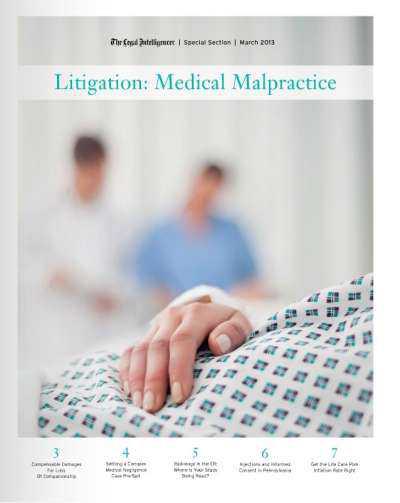Tom Duffy article: “Radiology in the ER: Where Is Your Study Being Read?”

This article originally appeared in a special "Litigation: Medical Malpractice" supplement of The Legal Intelligencer on Tuesday, March 26, 2013.
The Philadelphia area has five accredited Level I adult trauma centers. To receive the designation of a Level I trauma center, the hospital must be able to provide the highest level of definitive, comprehensive care for the severely injured adult patient. Under the 2011 standards for trauma center accreditation, a Level I facility must have an attending radiologist capable of diagnostic, invasive and therapeutic procedures promptly "available" 24 hours a day. The accreditation requirement does not require an attending radiologist be present in-house and leaves it to the discretion of the hospital if the attending radiologist must respond in-house.
Thus, even a Level 1 trauma center isn't required to have an attending radiologist in-house 24/7. Many area hospitals utilize teleradiology services during the night to read and interpret diagnostic studies. As a result of improvements in technology, imaging can be easily transmitted to remote locations, thus saving physicians the time of having to travel back to the hospital to interpret a study or film that could be done on the computer at their homes. In its nascent stage, the idea of having a radiology resident reviewing a film in-house and the attending physician confirming a diagnosis remotely has advantages for the patient, the physician and the institution. When important care decisions depend upon the interpretation of a diagnostic study in the middle of the night, it would seem better not have to rely on the "wet" reading of the surgeon backed up only by a radiology resident. An attending radiologist can then participate, but doesn't have to be in-house overnight. Smaller hospitals (and non-teaching hospitals) also benefit from teleradiology and theoretically can improve patient care in a cost-effective manner. When teleradiology studies are provided by a Pennsylvania-licensed radiologist and the practitioner is affiliated directly with the institution where the patient is receiving care, it can be a cost-effective way to improve patient care.
Unfortunately, many hospitals, recognizing the financial advantages of outsourcing radiological services, have begun to outsource not only beyond their own institution, but outside the borders of the United States. Digital technology enables the hospital to transmit the images anywhere around the world, leading to the use of overseas radiologists to do interpretations. Some of the big players in providing these services include NightHawk Radiology Services, Teleradiology Solutions and Virtual Radiologic Consultants. There are some obvious drawbacks to teleradiology, including the lack of communication between the clinician and the doctor reading the study, but what is more alarming is that when the studies are being preliminarily interpreted overseas, there currently exists no requirement that the physicians overseas providing the interpretations are subject to the same credentialing requirements of the hospital's real staff.
Under federal law, Medicare will not pay for medical services performed outside the United States. However, offsite radiology services work around the Medicare reimbursement problem by performing preliminary interpretations that are contracted and paid for by the local radiology group servicing the hospital. The next day, a member of the radiology group in the United States follows up the primary interpretation with a final reading, which is then billed to Medicare. Currently, there are more than 20 companies throughout the United States that have reading rooms overseas, in places like India, Israel, Australia and Hong Kong.
The lack of transparency in the use of teleradiological services by hospitals has kept the issue out of the public eye. A problem endemic to the delivery of medical care in the United States is a culture that abhors transparency, especially at teaching hospitals. The outsourcing can impact patient care, but at its core it's a practice that many would consider to be deceptive and misleading. Most patients know and accept that hospitals commonly outsource certain laboratory tests to third parties, but few patients would think to question the source of the reading of a CT scan. Patients often select an institution based on its overall reputation. Patients and family members are often asked to make life-or-death decisions about treatment options in the middle of the night, but currently there is no requirement that hospital staff disclose to patients the location of the practitioner interpreting the radiology studies.
A review of the press identified only two hospitals in the Philadelphia area that admitted using teleradiology services from overseas providers. Both institutions identified Israel as the location, but noted that the readings were done by radiologists licensed to practice medicine in Pennsylvania. It is well known that many hospitals rely on overseas providers to read studies overnight, but few will admit it publicly. Presently, there exists no recognized requirement that treatment recommendations being conveyed to the patient or family include a disclosure that they are based upon interpretations provided by practitioners not directly affiliated with the hospital or, even worse, not located in the United States.
In 1965, the Pennsylvania Supreme Court abolished the doctrine of charitable immunity for hospitals as a defense in tort cases. However, until 1990, the only liability a hospital faced was vicarious liability for the acts of its employees. In 1990, for the first time, the Pennsylvania Supreme Court recognized in Thompson v. Nason Hospital,527 Pa. 330, 591 A.2d 703 (1991), that certain hospitals could be directly liable to patients under the doctrine of corporate liability, which established a duty that the hospital owes directly to the patient to oversee all persons who render care to its patients and to adopt adequate policies to ensure quality care for patients. Because corporate liability involves direct negligence of the hospital (as opposed to vicarious liability for the act of a hospital employee) and is based on the negligent acts of the institution arising from its policies, an injured party need not establish the negligence of a doctor to prevail under a theory of corporate liability.
In 2002, the law of informed consent in Pennsylvania was legislatively changed to include misrepresentation as a basis for an informed consent claim where a patient was misled as to the doctor's training, experience or credentials. Traditionally, an informed consent was limited in its application (as a tort of battery) to individual physicians and not the hospital. The use of teleradiology without full disclosure is no less misleading to a patient than a surgeon exaggerating his or her experience performing a procedure and goes to the heart of a hospital's duty to its patients. A patient injured as a result of a suboptimal reading performed by a teleradiologist not subject to the credentialing requirement of the hospital's own staff may have a prima facie case of corporate negligence against the institution. But a patient should also be able to bring an action against the institution premised on the same grounds as an informed consent claim against an individual physician. Whether the Pennsylvania Supreme Court would recognize such a claim under Thompson remains to be seen, but it could only serve to improve the hospital's incentive to accurately disclose who is really providing care.
Although teleradiology is likely here to stay, its use needs to be coupled with requirements of disclosure and better, more uniform regulations concerning the credentials, training and licensing of the practitioner performing services offsite and outside of the United States.
Tom Duffy of Duffy + Partners regularly represents patients in cases involving significant medical malpractice and birth injury. In 2011, he obtained a $21 million verdict in a case involving Emergency Room care.

